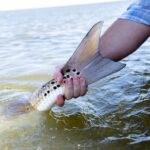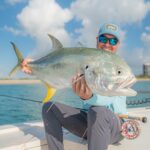
Bowfishing Banned in Biloxi Marsh
Feature Photo: Carter Abramson | Simms Fishing at the Fisheries Science Symposium We have more
When the sun came up over the marsh on Thursday, July 6th, the redfish cruised the tidal ponds, while sheepshead tailed on crabs and the jacks acted like jacks: crushing bait with all the ferocity of Mike Tyson in his prime. But on this morning something was a little different. There were fewer boat wakes rolling between the banks and no emphatic rally cries from eager anglers to be heard. There weren’t as many skiffs on the water this morning. Prime parking availability at the marina was at an all-time high. Instead, those boats were left sitting in their driveways like a good hunting dog looking out the window when their owner’s truck drives away.
On Thursday, July 6th, 2023, those trucks were filled with Louisiana guides who canceled their fishing trips, shifting their priorities from their preferred daily routine on the water. They didn’t cancel trips to catch up with their families, nor did they make any progress on their honey do’s. Instead, they drove towards Baton Rouge from all corners of the state on a mission. They demanded that their voices be heard in a critical environment: the Louisiana DWF meeting in which redfish limits in Louisiana were to be formally considered for the first time in over a generation.
Louisiana still has fantastic fishing opportunities. It sits atop many angling bucket lists and it should remain there. However, the redfish numbers are in decline. In 2009, the abundance at age estimate put the population at slightly over 21 million. By 2021, that number dwindled to 8.7 million. Louisiana Division of Wildlife and Fish did a stock assessment on redfish at the end of 2022, during which new projections were made for what a variety of new slot limits would do to rebuild the stock.
Redfish are measured on Escapement Rate and Spawning Potential Ratio. The first is the percentage of juvenile fish that recruit to the adult stock. The second (SPR) is the age structure and number of sexually mature redfish. The SPR is much more difficult to rebuild in comparison. This is a reality because redfish grow so fast for the first few years. Once they mature, their growth rates are like white oaks; they grow very slowly. The older and larger a female redfish gets, the more eggs she produces – much like striped bass. Ergo, rebuilding that spawning potential takes time.
This LDWF hearing was meant to generate a Notice of Intent (NOI) to do two things. First, cease killing big redfish. The second issue was tightening the slot to create a reduction that would begin rebuilding escapement rates and SPR. The current limit is 5 fish 16-27” with one fish allowed over slot. LDWF suggested a 35% reduction in harvest. While this would have lowered escapement to acceptable levels in a decent timeframe, it would not have recovered SPR to target for 29 years.
The truth is that the LDWF decision to suggest a 35% reduction was largely influenced by a recent debacle over speckled trout. Yes, trout are in trouble too. LDWF did a rock-solid stock assessment for their beloved, big-fanged fish and wanted to change the trout regs from 25 fish at 12” to 15 fish at 13.5”. This action went through the state process and only had to be approved by the state legislature. At the last second, the effort was thwarted. Some suggest recreational fishing organizations killed it. When it came to reconsidering redfish, LDWF didn’t want to repeat this experience. They knew something had to be done. So, they did what they thought they could. It’s hard to criticize that.
29 years is a long time. A lot can happen between now and then. Many of us simply hope to be upright and physically able to enjoy the great outdoors 29 years from now. And if we’re not, we will most certainly watch from the sidelines with a smile on our faces as our children and grandchildren do so. Our guides target those big fish for catch-and-release opportunities. This experience is an anchor for so many businesses in Louisiana. They have built their lives on those fish. If the reduction was increased by only 15%, SPR could be back at the target 16 years sooner. You know our stance when it comes to situations like this…
Better Business Through Conservation.
This timely opportunity for change is why guides from around the state converged on the commission meeting. While this obviously wasn’t the ASGA team’s first rodeo in this setting, for many of those in attendance it was. Taking a leap into the social spotlight to stand up for what you believe is a big jump – especially in Louisiana. The significance of this leap is so daunting that many have gone their professional lives without speaking up – and often regret not doing so when the dust settles. Not to our surprise (having spent time with these gentlemen at community events and many late-night fisheries discussions on the phone), they were eloquent, informed, respectful and insightful. One after another, they stepped up to the podium and gave well-informed comments to the commissioners. Believe it or not, the commissioners listened.
Based on the overwhelming comments, the commissioners decided to change their course. A motion was made to adjust the slot to 18-24” with a 3 fish limit with no overs and no guide limit. That motion passed 4-2. The room pretty much erupted – about 80% consisting of cheering from our guides. The other 20% consisted of murmuring from other parties, soon to stomp out of the room like entitled toddlers who got their screen time taken away.
The Louisiana guide community gave LDWF and the Commission the political will to push back against the groups that have controlled that area for quite some time. It was an amazing thing to watch. We couldn’t be more proud of the courageous guides willing to speak up for their fisheries. The voice of conservation in this state now has a platform. The Louisiana marsh is a national treasure and a fisheries economic engine that is second to none. We have a long way to go before the legislature passes these options. If you have ever caught a redfish in Louisiana or plan to one day travel south to do so, now is the time to step up and help this community defend their resource and their livelihoods. As ASGA continues to grow and expand, we remain committed to creating an army for fisheries conservation.
If we all stick together, the future of our fisheries becomes much brighter.
Want to learn more about the red drum situation in the bayou?
Head to ASGA’s Lousiana Redfish Hub to find additional resources like podcasts and stock assessment breakdowns.

Credits: Photo 1 – Capt. Ty Hibbs
Credits: Photo 2 – Capt. Bailey Short

Feature Photo: Carter Abramson | Simms Fishing at the Fisheries Science Symposium We have more

Each year, hundreds of millions of fish are killed as collateral damage from large-scale, inshore

Feature Photo Credit: Scientific Anglers Team At the heart of the Jack Project is a

Header Photo: Camden Spear Over the past several years, ASGA has consistently championed science-based, precautionary
We rely on our members and donations to keep fighting for a sustainable tomorrow in marine conservation.
GIVE THE GIFT OF FISHERIES CONSERVATION THIS HOLIDAY SEASON. SHOP ASGA GOODS THAT FUND FISHERIES RESEARCH & ADVOCACY CAMPAIGNS
JOIN ASGA IN CALLING FOR CRITICAL MANAGEMENT ACTION AFTER YEARS OF SPAWN FAILURES & POOR MANAGEMENT.
By using this website, you agree to our use of cookies. We use cookies to provide you with a great experience and to help our website run effectively. To learn more, please review our privacy policy.
3 Responses
No guide limit?
Does this mean guides can keep all the redfish they want while the general public can keep 3 daily?
Pedro,
Thanks for the comment! There will be no guide limit at all with the new regulations.